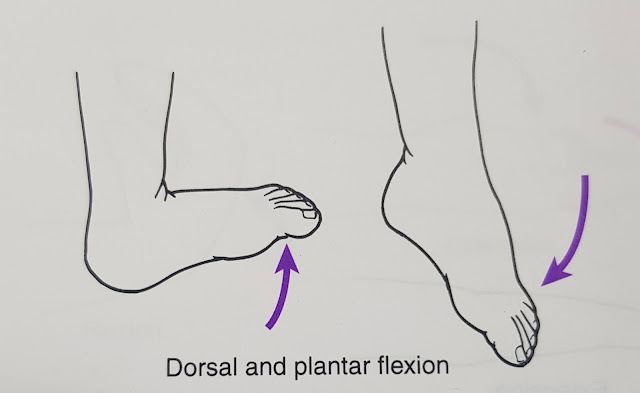ការធ្វើលំហាត់កម្រិតចលនា
(Range of Motion Exercises)
សម្ភារ
·
ស្រោមដៃស្អាត
·
គ្រែដែលមានពូករឹង
ឬ តុ
·
ភួយសម្រាប់ដណ្តប់បិទបាំង
ពាក្យក្នុងការប្រើប្រាស់សម្រាប់ការធ្វើលំហាត់កម្រិតចលនា
|
ចលនា |
និយមន័យ |
ការប្រើប្រាស់ |
|
Circumduction |
ធ្វើចលនាសន្លាក់ជារង្វង់មូល |
ប្រើសម្រាប់ការធ្វើចលនាស្មា |
|
Hyperextension |
បត់សន្លាក់ដែលមានផ្នែកជិតគ្នា ឲ្យមានចលនារំកិលរកគ្នា
ធ្វើឲ្យកាត់បន្ថយមុំកែងនៃសន្លាក់ដែលនៅចន្លោះផ្នែកទាំង ២ នោះ
ហើយកាត់បន្ថយមុំកែងដែលនៅចន្លោះឆ្អឹងទាំង ២ នោះ |
ប្រើក្នុងការធ្វើចលនារបស់ដៃ, ជើង, ប្រអប់ដៃ, និង កដៃ |
|
Flexion |
ការបត់សន្លាក់ដែលផ្នែកទាំង២ បត់ចូលរកគ្នា ធ្វើដូចនេះ |
ប្រើក្នុងការធ្វើចលនារបស់ស្មា, កែងដៃ, ជង្គង់, និង
ម្រាមដៃ |
|
Extension |
ចលនាបង្កើនមុំកែងរវាងឆ្អឹងភ្ជាប់គ្នា ២ |
ប្រើក្នុងការធ្វើចលនារបស់ដៃ, ជើង, ប្រអប់ដៃ, និង កដៃ |
|
Internal rotation |
ធ្វើចលនាងាកចេញពីខ្សែបន្ទាត់កណ្តាល |
ប្រើក្នុងការធ្វើចលនារបស់ក្បាល ពីម្ខាងទៅម្ខាងទៀត |
|
Abduction |
ធ្វើចលនាចេញពីខ្សែបន្ទាត់កណ្តាលនៃដងខ្លួន |
ប្រើក្នុងការធ្វើចលនារបស់ ជើង, ដៃ, និង ម្រាមដៃ |
|
Adduction |
ធ្វើចលនាចូលមកខ្សែបន្ទាត់កណ្តាលនៃដងខ្លួន |
ប្រើក្នុងការធ្វើចលនារបស់អវៈយវៈ ជើង, ដៃ, និងម្រាមដៃ |
|
Pronation |
ត្រឡប់កំភួនដៃ ដែលធ្វើឲ្យផ្ទៃនៃបាតដៃ ផ្កាប់ចុះក្រោម |
ប្រើក្នុងការធ្វើចលនារបស់ប្រអប់ដៃ, និង ម្រាមដៃ |
|
Supination |
ត្រឡប់កំភួនដៃ ដែលធ្វើឲ្យផ្ទៃនៃបាតដៃ ផ្ងារឡើងលើ |
ប្រើក្នុងការធ្វើចលនារបស់ប្រអប់ដៃ, និង ម្រាមដៃ |
|
Deviation |
បន្តឹង ឬបន្ធូរ កដៃ |
ប្រើក្នុងការធ្វើចលនារបស់កដៃ |
|
Opposition |
ដាក់ផ្ទៃបាតដៃនៃមេដៃ ដែលអាចឲ្យប៉ះគល់ម្រាមដៃ |
ប្រើក្នុងការធ្វើចលនារបស់ប្រអប់ដៃ |
ការអនុវត្តន៍លំហាត់កម្រិតចលនា
1. តំឡើងគ្រែ ឬ តុ
រហូតដល់កំពស់សមល្មមដើម្បីងាយស្រួលអនុវត្តទម្រង់ការ
2. លាងដៃ និងពាក់ស្រោមដៃស្អាត
ប្រសិនបើអាចប៉ះពាល់វត្ថុរាវសរីរៈ
3. ដាក់ស្ថានភាពកុមារក្នុងដំណេកផ្ងារ នៅលើគ្រែ ឬតុ
4. ដណ្តប់ភួយកុមារ ដោយចំហរអវៈយវៈដែលត្រូវអនុវត្តលំហាត់នីមួយៗ
5. ក. អនុវត្តលំហាត់ប្រាណដែលសមស្របតាមអ័ក្ស cephalocaudal ដោយចាប់ផ្តើមពីចំហៀងម្ខាងនៃដងខ្លួន
បន្ទាប់មកម្ខាងទៀត។
ខ. លំហាត់ប្រាណនីមួយៗ
គួរតែអនុវត្តពី ៣ ទៅ ៥ ដង យឺតៗ និងមានចលនាស្មើៗគ្នា
គ.
ត្រូវដាក់ទម្រទ្រអវៈយវៈដែលត្រូវការជំនួយ នៅពេលបង្ខាំងចលនាសន្លាក់ក្នុងលំហាត់កម្រិតចលនា។
6. ប្រសិនបើសាច់ដុំកន្រ្តាក់រឹង ត្រូវបន្ថយសម្ពាធបន្តិចម្តងៗ
ហើយទប់ស្ថានភាពសន្លាក់រហូតដល់ការកន្រ្តាក់ថយចុះ។
7. ប្រសិនបើកុមារមានការឈឺចាប់ ឬគ្មានផាសុកភាព
ត្រូវបញ្ឈប់ការធ្វើលំហាត់នោះភ្លាម
8. តាមដានកុមារ រកមើលសញ្ញាវិបត្តិដំណកដង្ហើម ឬបេះដូង
អំឡុងពេលអនុវត្តលំហាត់នេះ
9. ផ្តល់ស្ថានភាពដែលជួយសម្រួលដល់ការអនុវត្តលំហាត់កម្រិតចលនា
ដល់កុមារ
10. បន្ទាបគ្រែ ឬតុមកវិញ។
ប្រសិនបើកុមារត្រូវបានផ្លាស់ពីគ្រែរបស់គាត់ ត្រូវជួយកុមារឲ្យត្រឡប់ទៅបន្ទប់និងគ្រែរបស់គាត់វិញ
និងដាក់ស្ថានភាពផាសុកភាព និងសុវត្តិភាព។
11. ដោះស្រោមដៃ និង លាងដៃ
ចំណាំ៖ នៅពេលអនុវត្តលំហាត់កម្រិតចលនានៅដៃរបស់កុមារ
បើកុមារត្អួញថា មានការឈឺចាប់នៅនឹងអវៈយវៈ ដូចគេចាក់នឹងកាំបិត
ត្រូវបញ្ឈប់ការអនុវត្តភ្លាម រួចវាយតម្លៃការឈឺចាប់។ ការអនុវត្តលំហាត់កម្រិតចលនា
មិនគួរធ្វើឲ្យមានការឈឺចាប់នោះទេ។ សន្លាក់ទាំងអស់ ត្រូវប្តូរចលនារហូតមានការរាំងស្ទះ
តែទោះជាយ៉ាងណា ការឈឺចាប់ដូចចាក់នឹងកាំបិត មិនគួរមាននោះទេ។ ត្រូវរាយការណ៍ដល់គ្រូពេទ្យ
អំពីការឈឺចាប់របស់កុមារ និងត្រូវកំណត់នូវការរៀបចំផែនការលំហាត់នេះសាឡើងវិញ។
រូបភាពនៃប្រភេទចលនា
រៀបចំដោយ៖
ស៊ិនកេត រ៉ាណែត
ត្រួតពិនិត្យ៖
អក្ខរាវិរុទ្ធ៖
Range of motion exercise
Equipment
·
Non sterile gloves
·
Bed with firm
mattress or padded table
·
Blanket for privacy
Range
of motion terminology
|
Movement |
Definition |
Use |
|
Circumduction |
Movement of the joint in a full circle |
Used in movement of the shoulder |
|
Hyperextension |
Movement
of the joint in the direction of extension beyond a straight line |
Used
in movement of arms, legs, hands, and wrists |
|
Flexion |
The bending of the joint in which the two adjacent
parts move toward each other, thus reducing the angle of the joint between
two parts. Decreasing the angle between two bones. |
Used in the shoulder, elbow, knee, and finger joints |
|
Extension |
Movement
increasing angle between two adjoining bones |
Used
in the shoulder, elbow, knee, and finger joints |
|
Internal rotation |
Turning away from midline |
Used in movement of the head from side to side |
|
Abduction |
Movement
away from the midline of the body |
Used
in movement of legs, arms and fingers |
|
Adduction |
Movement toward the midline of the body |
Used in movement of extremities, legs, arms, and
fingers |
|
Pronation |
Turning
the forearm so that the palmar surface of the hand is facing downward |
Used
in movement of hand and wrists |
|
Supination |
Turning the forearm so that the palmer surface of the
hand is facing upward |
Used in movement of hand and wrist |
|
Deviation |
Abduction
or adduction of the wrist |
Used
in movement of the wrist |
|
Opposition |
Placement of the palmar surface of the thumb so that it
touches the base of the fingers |
Used in movement of the hand |
Performing
range of motion exercises
1.
Raise bed or padded
table to a comfortable working level for the practitioner
2.
Perform hand hygiene,
and don gloves if contact with body fluids is possible
3.
Position the child in
a supine position on bed or padded table
4.
Cover the child with
blanket, exposing only the extremity involved in each specific exercise
5.
A. Conduct
appropriate exercises along the cephalocaudal axis, first on one side of the
body and then on the other
B. Each exercise should be performed
three to five times in a slow, smooth, and even movement
C. Support the dependent extremity
while putting an immobilized joint through ROM exercises.
6.
If muscle spasm
occurs, decrease the pressure slightly and keep the joint in a functional
position until spasm eases
7.
If the child exhibits
pain or discomfort, discontinue the exercise
8.
Observe the child for
respiratory or cardiac distress during the procedure
9.
Provide the child
with position reinforcement for performing ROM exercises
10. Return bed or padded table to low position. If the child was
moved from own bed, assist the child back to his/her room, and return the child
to a comfortable and safe position in his/her bed
11. Remove gloves, if donned and perform hand hygiene
Note: While performing ROM exercises on the child’s arm, the
child complains of sharp pain in that extremity. Stop the ROM exercises.
Further evaluate the pain. ROM exercises
should not be painful. Joints are moved until there is resistance; however,
sharp pain should not be present. Notify the health care prescriber of the
child’s pain to further determine whether the exercise plan should be revised.
Reference
Vicky,
R. B., & Cindy, S. G. (2012). Pediatric Nursing Procedures (3rd ed.). Fullerton,
CA: Lippincott. (pp: 625-632)
Prepared
by SRN
Checked
by

































